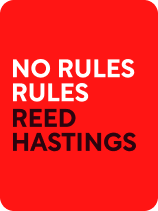

This article is an excerpt from the Shortform book guide to "No Rules Rules" by Reed Hastings. Shortform has the world's best summaries and analyses of books you should be reading.
Like this article? Sign up for a free trial here .
What are 360-degree reviews? How are they run and why do they offer better feedback?
A 360-degree review is a process in which every peer, subordinate, and manager or supervisor provides feedback to an individual. It is also known as multisource feedback.
Keep reading for more about 360-degree reviews and how they’re used at Netflix.
How to Use 360-Degree Reviews
The culture of candor helps each employee achieve peak performance through frequent, candid feedback—but no matter how much you preach the benefits of candor, some people will still avoid giving and receiving honest feedback because it’s often uncomfortable. For that reason, Hastings implemented two processes to ensure that everyone participates.
Process 1: Annual Written 360-Degree Reviews
Hastings wanted a formalized way for employees to receive feedback, but he felt that the standard performance review that many companies use had too many shortcomings:
- Feedback only goes in one direction—from superiors to subordinates. This also goes against Netflix’s motto not to aim to please your boss.
- You don’t get a chance to hear feedback from coworkers, which could provide different insight than your boss’s review because they work with you in a different capacity.
- Many companies base performance reviews on whether you’ve reached a set of annual goals, and they use this to determine your raise. However, as discussed in Chapter 4, Netflix doesn’t set annual goals, and it bases salary raises on market values, not performance benchmarks.
Instead of a traditional performance review, Hastings and the executive team implemented an annual written 360. (Shortform note: A “written 360” refers to 360-degree reviews, which are also called multisource feedback, multi-rater feedback, or multisource assessment.) In the written 360, each employee receives written feedback from any colleague who wants to give it—including bosses, supervisors, coworkers, and subordinates. Comments must be actionable and constructive, and they should be given in a Start, Stop, Continue format. (Shortform note: This format includes suggestions for what the employee should start doing, stop doing, and continue doing in order to improve.)
The annual 360-degree reviews are not tied to raises, promotions, or firings—rather, they’re purely meant to give each employee the opportunity to give and receive thorough feedback. The culture of candor dictates that there already should be a constant stream of feedback, but Hastings views the written 360 like an annual teeth cleaning at the dentist: Even though you brush every day, you need a thorough cleaning to get to all those hard-to-reach and uncomfortable areas that you’ve been missing. Despite Netflix’s open and honest culture, certain suggestions are hard for many people to give and receive, and those comments can be vital to improving someone’s performance, so this process ensures that they don’t get glossed over.
Written 360s Are Not Anonymous
When Hastings first implemented the written 360s, he allowed comments to be anonymous so that people could feel comfortable being totally open. However, this didn’t have the intended effect:
- For many employees, anonymity felt contrary to the culture of candor the company promotes. In fact, many employees chose to sign their names despite the option to remain anonymous.
- Occasionally, commenters felt the need to keep their feedback vague in order to hide their identity—but, as a result, the comments were not specific and concrete enough to be helpful and actionable.
- Some people left comments that were rude or sarcastic because they could hide behind the anonymity.
After a couple of years, Hastings struck the anonymous option and found that when employees left their names with their comments:
- They gave more concrete feedback, which helped the receiver make improvements.
- They put more effort into their comments, because their names and credibility were attached.
- It enabled feedback receivers to follow up with commenters about their feedback and how to improve. The written 360 became a starting point for discussions that were more valuable than the comments that initiated them.
The written 360s sparked productive conversations for many employees, but not everyone—some people continued to avoid confronting awkward feedback. Just as Hastings put this process in place to guarantee that all employees gave and received constructive feedback, he developed a second process to ensure that they also talked about it.
Process 2: Live 360-Degree Reviews
Hastings saw that the biggest benefit of the written 360s were the discussions that grew out of the written comments, so he implemented face-to-face 360-degree reviews. In a live 360, a manager and her team gather for several hours and go around the room as each employee takes a turn receiving feedback. This format has multiple benefits:
- It provides insight into the interpersonal dynamics of the team as a whole by enabling everyone to hear teammates’ comments to each other. If one person offers a suggestion, someone else can dispute or build on it, and the person receiving the feedback gets a sense of how she may be effective in one context but need improvement in another area.
- Each employee becomes more accountable to her team, which improves the team’s overall effectiveness and collaboration. This also reinforces the principle of acting in the best interest of the company instead of merely trying to please the boss.
Even if you’re acclimated to the company’s culture of candor, fielding constructive criticism from your entire team in front of your entire team can be daunting. However, no one aims to attack or embarrass their teammate—especially because they’ll also have a turn on the hot seat. The culture of candor and accountability also ensures that employees will call out a coworker whose comments are out of line. Although some employees still see the process as uncomfortable and potentially embarrassing, if they can be receptive to comments and avoid getting defensive, the feedback could save them from failing a future Keeper Test.
Tips for Conducting a Live 360
Live 360s can only work if you have a high talent density and if you’ve trained employees to give and receive feedback following the 4A guidelines outlined in Chapter 2. Additionally, you can take other steps to ensure a successful discussion:
- Allow several hours for the live 360, preferably over dinner or another meal outside of the office.
- Make sure the group is small enough to be manageable—ideally eight people or fewer. Typically, you’ll need about three hours for eight people, and about five hours for a group of 12.
- Begin the session by explaining that all feedback must be actionable and follow the 4A guidelines. The leader must be a strong moderator to monitor feedback during the discussion.
- Encourage everyone to focus more heavily on constructive feedback (“start or stop doing this”) than on positive feedback (“continue doing this”). A ratio of about 25 percent positive feedback and 75 percent developmental feedback is a healthy balance.
- Choose someone who is open and receptive to tough feedback to be the first one on the hot seat. Ideally, the boss should go first to set the tone for the rest of the team.
Exercise: Are You Missing Important Feedback?
Reflect on the kind of feedback that could help you improve your performance.
- Describe your current performance review process.
- If you were to do a written 360, who would you like to get feedback from?
- What kind of feedback would you hope to receive (for example, pertaining to your professional skills or your ability to collaborate)?
- If your company doesn’t have a process for you to get the feedback you’re interested in, how could you solicit it from your colleagues?

———End of Preview———
Like what you just read? Read the rest of the world's best book summary and analysis of Reed Hastings's "No Rules Rules" at Shortform .
Here's what you'll find in our full No Rules Rules summary :
- How Netflix achieved massive success in a short period of time
- The unusual business practices that have helped Netflix sustain its success
- Why Netflix fires adequate employees






